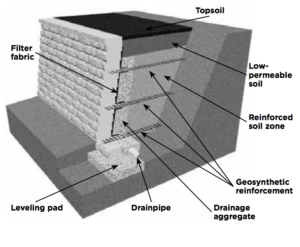 When it comes to landscaping and property management, retaining walls play a crucial role in ensuring stability and preventing soil erosion. Whether you have a sloped landscape, terraced garden, or want to add an appealing feature to your outdoor space, a retaining wall can be an excellent solution. In this article, we will explore the importance of retaining wall installation, the key steps involved, and the benefits of hiring professional contractors for the job.
When it comes to landscaping and property management, retaining walls play a crucial role in ensuring stability and preventing soil erosion. Whether you have a sloped landscape, terraced garden, or want to add an appealing feature to your outdoor space, a retaining wall can be an excellent solution. In this article, we will explore the importance of retaining wall installation, the key steps involved, and the benefits of hiring professional contractors for the job.
Understanding the Purpose of Retaining Walls
Retaining walls are structures designed to hold back soil and create level surfaces on sloped terrains. They serve various purposes, including:
- Preventing soil erosion: Retaining walls help retain soil in elevated areas, preventing it from washing away during heavy rains or irrigation.
- Terrace construction: They are used to create tiered landscapes, adding visual appeal and maximizing space utilization.
- Enhancing stability: Retaining walls add structural support to landscapes and prevent land movement or sliding.
The Key Steps in Retaining Wall Installation
1. Site Inspection and Planning
The first step in installing a retaining wall is a comprehensive site inspection. Professional contractors assess the landscape’s topography, soil composition, and drainage patterns to design a suitable retaining wall. They consider factors like the wall’s height, material selection, and any necessary reinforcements.
2. Material Selection
Retaining walls can be constructed using a variety of materials, including concrete blocks, natural stones, wood, or bricks. The choice of material depends on factors such as budget, aesthetics, and the wall’s intended purpose. Professional contractors help clients select the most suitable material for their specific needs.
3. Excavation and Foundation Preparation
Once the design and material selection are finalized, the installation process begins with excavation. Contractors dig a trench where the base of the retaining wall will be placed. This trench is then filled with gravel or crushed stone to create a stable foundation.
4. Building the Retaining Wall
With the foundation ready, the construction of the retaining wall commences. Contractors carefully lay the chosen materials, interlocking them securely to create a stable structure. Proper drainage systems are incorporated to prevent water buildup behind the wall.
5. Backfilling and Compaction
After the wall is in place, backfilling is done to fill the space between the wall and the excavated slope. Proper compaction of the backfill ensures the stability and longevity of the retaining wall.
6. Finishing Touches
To enhance the appearance of the retaining wall, contractors may add finishing touches such as decorative caps, planters, or seating areas. These features add both functionality and aesthetic appeal to the structure.
Benefits of Hiring Professional Retaining Wall Contractors
1. Expertise and Experience
Professional contractors have the expertise and experience to design and construct retaining walls that meet the highest standards of quality and durability. Their knowledge ensures that the wall will withstand the pressures of the surrounding landscape for years to come.
2. Compliance with Regulations
Local regulations and building codes may govern the construction of retaining walls. Professional contractors are well-versed in these regulations and ensure that the installation adheres to all necessary guidelines.
3. Time and Cost Efficiency
Hiring professionals saves time and money in the long run. They work efficiently, complete the project on schedule, and reduce the risk of costly errors or rework.
4. Enhanced Aesthetics
Experienced contractors can create visually appealing retaining walls that complement the overall landscape design and add value to your property.
5. Long-Term Stability
A well-constructed retaining wall by professionals provides long-term stability and peace of mind, knowing that your property is protected from erosion and land movement.
Retaining wall installation is a vital aspect of landscaping and property management. A well-designed and properly constructed retaining wall can transform your outdoor space while providing essential structural support. Hiring professional contractors ensures that the installation is done correctly, adhering to regulations and best practices. So, if you’re considering a retaining wall for your property, don’t hesitate to seek the expertise of experienced contractors to build a strong foundation for your landscape.
FAQs
Q1: Can I install a retaining wall myself? A1: While some homeowners may attempt DIY retaining wall installation, it is a complex task that requires specialized knowledge and skills. Hiring professional contractors is recommended for optimal results.
Q2: How long does it take to install a retaining wall? A2: The timeline for retaining wall installation varies depending on the project’s size and complexity. Typically, it can take a few days to a few weeks to complete the process.
Q3: Do I need a permit for retaining wall installation? A3: In many areas, permits are required for building retaining walls exceeding a certain height. Professional contractors can guide you through the permit process and obtain the necessary approvals.
Q4: Are there eco-friendly options for retaining wall materials? A4: Yes, there are eco-friendly options such as recycled materials or permeable retaining walls that promote better drainage and reduce water runoff.
Q5: Can a retaining wall add value to my property? A5: Yes, a well-designed and properly constructed retaining wall can enhance your property’s curb appeal and functionality, potentially increasing its value.

